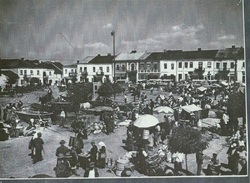
Stopnica was a thriving market town surrounded by farmland prior to World War II. My understanding is that perhaps 3/4 of the town was Jewish, and that relations between Christian and Jews were generally amicable. The outbreak of World War II changed everything: Most of the Jews were killed in Nazi concentration camps, and the town was devastated in the fierce fighting between German and Russian forces.
Rebuilt after World War II, Stopnica continues to be a quiet village, anchored by a cathedral and a tree-lined square. There are no Jews in the town, and no obvious signs of the Jewish past, though a building that once served as a mikvah still stands. There are now probably only a handful of people in the town old enough to remember the Jewish presence in the town. When I had the chance to visit the town in 2002, an old man pointed out the site of a kosher butcher, a "Jewish" grain mill, and a sprawling green field at the edge of town that once belonged to a Jewish farmer. He also noted that his family bought his house from a Jewish family that moved to South America in the 1930s, a fact that was later confirmed for me by one of the town's few Jewish survivors.
Two grassy areas in the town were once Jewish cemeteries. The old cemetery, close to the center of the town, has no visible headstones and is surrounded by a fence on the property of a storage building. The new cemetery is located a short distance away in a grassy meadow through which high-power lines run. Broken stone slabs that suggest gravesites are visible under the tall grass, but there are no identifying markers. Interestingly, the old man who guided me to the cemetery used the Hebrew word "matzevah" for headstones, though he probably hadn't seen a Jew in some six decades. He also told me that as a child he surreptitiously witnessed German soldiers executing alleged Polish partisans in this cemetery, and that their wives had to pay to recover their husband's remains.
Jews from Stopnica formed at least two landsmanschaften in New York City in the early 1900s. YIVO has records from Chevra Oir Lashumaim Anshei Stopnitz from 1925-1947, but they are in Yiddish and it's not clear if they contain membership lists or information on their formation or dissolution. The other, the Stopnitzer Young Men's Benevolent Society, has chapters in both New York and Toronto, largely composed of Holocaust survivors and their descendants. Recently, descendants of Jews from Stopnica have also created a Facebook page.
The Toronto organization has a web site with remembrances and useful historical and genealogical information: http://www.stopnitzer.ca
You can reach the New York organization here: http://www.stopnitzernyc.org
Rebuilt after World War II, Stopnica continues to be a quiet village, anchored by a cathedral and a tree-lined square. There are no Jews in the town, and no obvious signs of the Jewish past, though a building that once served as a mikvah still stands. There are now probably only a handful of people in the town old enough to remember the Jewish presence in the town. When I had the chance to visit the town in 2002, an old man pointed out the site of a kosher butcher, a "Jewish" grain mill, and a sprawling green field at the edge of town that once belonged to a Jewish farmer. He also noted that his family bought his house from a Jewish family that moved to South America in the 1930s, a fact that was later confirmed for me by one of the town's few Jewish survivors.
Two grassy areas in the town were once Jewish cemeteries. The old cemetery, close to the center of the town, has no visible headstones and is surrounded by a fence on the property of a storage building. The new cemetery is located a short distance away in a grassy meadow through which high-power lines run. Broken stone slabs that suggest gravesites are visible under the tall grass, but there are no identifying markers. Interestingly, the old man who guided me to the cemetery used the Hebrew word "matzevah" for headstones, though he probably hadn't seen a Jew in some six decades. He also told me that as a child he surreptitiously witnessed German soldiers executing alleged Polish partisans in this cemetery, and that their wives had to pay to recover their husband's remains.
Jews from Stopnica formed at least two landsmanschaften in New York City in the early 1900s. YIVO has records from Chevra Oir Lashumaim Anshei Stopnitz from 1925-1947, but they are in Yiddish and it's not clear if they contain membership lists or information on their formation or dissolution. The other, the Stopnitzer Young Men's Benevolent Society, has chapters in both New York and Toronto, largely composed of Holocaust survivors and their descendants. Recently, descendants of Jews from Stopnica have also created a Facebook page.
The Toronto organization has a web site with remembrances and useful historical and genealogical information: http://www.stopnitzer.ca
You can reach the New York organization here: http://www.stopnitzernyc.org